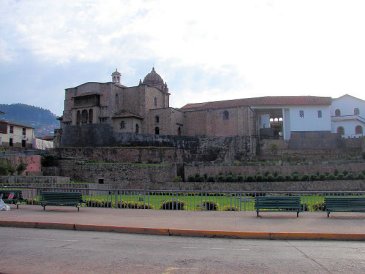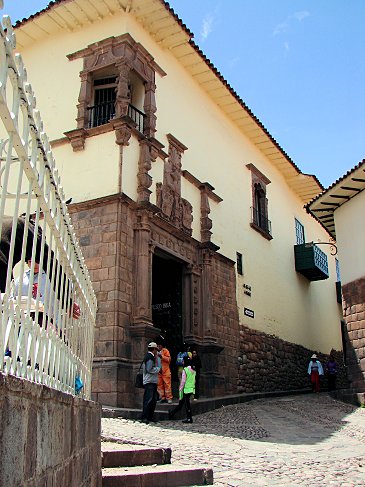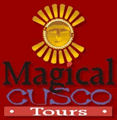Every year, thousands of tourists visit Cusco from all over the world. Cusco offers its visitors a wonderful choice of tourist attractions in the form of ancient Inca ruins and beautiful 16th Century Spanish colonial architecture. The major tourist attractions of Cusco include its� amazing Inca ruins, as well as elegant cathedrals, city squares, mansions, and various museums of the Spanish Period. Cusco also offers easy access to the popular ruins of the Sacred Valley of the Incas, Machu Picchu, and the Fortresses of both Sacsayhuaman and Ollantaytambo .
April - September is the high season for tourists visiting Cusco and the sometimes the aggressive children shining shoes or selling postcards, can turn off your enjoyment of Cusco, but we have found that Cusco is well worth the visit.
Cuzco temperatures range from 17 degrees C or 63 degrees F to 2 degrees C or 28 degrees F. The rainy season in Cusco runs from November to March.
The flag: The rainbow flag often seen in Cuzco is the flag of the Tihuanaco Empire, now the adopted as Cusco City's own.
Walking through the narrow streets of Cusco next to the ancient Inca Walls is like walking through an outdoor museum. The original Inca ruins often serve as the foundations of the buildings in the city of Cusco as it exists today.
There are a few areas where the Inca Walls stand out more than others. Some of the best areas to see Inca Walls are along the streets of Loreto and Hatunrumiyoc. Inca walls line both sides of Loreto, which runs southeast from the Plaza de Armas. The south wall is from Amarucancha, site of the Palace of Huayna Capac. On the north side of Loreto is the wall which belonged to the Acllahuasi and is one of the oldest walls in Cusco. Hatunrumiyoc runs northeast from the Plaza de Armas. This pedestrian only street is famous for the 12 sided stone found along the east wall. To find the stone look for the souvenir sellers which set up regularly directly across from the stone. The Church of Santo Domingo, which is also the site of Coricancha is another great example of Inca stone work. A curved, 6m high Inca wall lines one end of the Church of Santo Domingo and can be seen from the street or inside the church.
Here are a few descriptions of the various churches, cathedrals, and convents:
Catedral de Cusco:
Construction on the Cusco Cathedral was begun in 1559 and completed in 1669, in the Renaissance style. It is built on the site where the Inca Wiracochas Palace once stood.
Adjoining the Cathedral is the church of El Triunfo to the right, and the church of Jesus Maria to the left.
The Cusco Cathedral houses an impressive collection of art work, with over 400 paintings from the Escuela Cusquena. These paintings from the 16th and 17th century are unique in that they are European style with an obvious Andean Indian influence. This can be seen for example, in The Last Supper by Marcos Zapata, which shows the apostles dining on guinea pig. Also of note in the Cathedral are the 400 kg main altar made from silver, the cedar choir stalls, and other wood carvings.
The Capilla del Triunfo houses the famous Alonso Cortes de Monroy painting of the 1650 earthquake that devastated Cusco.
Click On The Above Photo Of The Catedral de Cusco To Go To Our Catedral de Cusco Web Page.
Compania de Jesus, or La Compania:
Compania de Jesus, or La Compania:as it is called, on the Plaza de Armas is a Jesuit church built in the 16th century. It was hit hard by the 1650 earthquake but was rebuilt and finished in the later 1660s. La Compania was the source of much controversy at the time it was constructed because of its grandeur which threatened to surpass that of the Cathedral located in the same square. The bishop of Cusco complained about the church and its lavish design and the argument was finally brought to Pope Paul III to arbitrate. The Pope sided with the Cathedral but by the time word of his decision reached Cusco, La Compania was almost completed. Consequently the Pope's decision had little influence and as a result, La Compania has an impressive ornate, baroque facade which rivals that of the Cathedral. It looks particularly beautiful at night when it is lite up.
La Compania is built on the Inca foundations of the Palace of Huayna Capac.
Click On The Above Photo Of The Compania de Jesus To Go To Our Compania de Jesus Web Page.
Capilla del Triunfo Of The Cathedral Of Cusco Peru:
The Capilla del Triunfo was the first Christian church built in Cusco. It is next door, to the right of the Catedral de Cusco.
Inside is a famous painting by Alonso Cort�s de Monroy; of the devastating earthquake of 1650.
Just to the right of the entrance of the Capilla (the right nave, next to the choir stalls) is an altar adorned by the locally famous "El Negrito" (also known as "El Se�or de los Temblores," or Lord of the Earthquakes). It is a brown-skinned figure of the crucificed Jesus Christ, known as the "Protector of Cusco."
This was paraded throughout the city, by the frightened residents during the 1650 earthquake (which, ceased shortly thereafter). So strong is the continued faith in "El Negrito," that the locals bring dozens of fresh flowers, in his honor, to the Capilla, on a daily basis.
A few years ago, the figure's crown was stolen, and not recovered; the one now adorning his head is made of gold; a gift of a local parishioner.
Click On The Above Photo Of The Capilla del Triunfo To Go To Our Capilla del Triunfo Web Page.
La Merced Church and Convent (Iglesia de La Merced):
The baroque-style colonial church and convent of La Merced was built between 1657 and 1680. The original church built on this site in 1536 was destroyed in the 1650 earthquake which devastated much of Cusco. La Merced is considered to be the third most important colonial church in Cusco, after the Cathedral and La Compania.
Inside the church are paintings based on the life of San Pedro Nolasco, who founded the Order of La Merced. One of the most impressive treasures in La Merced is a gold shrine with precious gems, found in the sacristy. Also contained in La Merced are the remains of the conquistadors Diego del Almagro and Gonzalo Pizzaro.
The church is located just south of the Plaza de Armas.
Museo de Arte Religioso).
The Museo de Arte Religioso (Museum of Religious Art) is housed in the impressive Archbishop's Palace (Palacio Arzobispal), which was once the residence of the Archbishop of Cusco. This colonial palace features Moorish-style doors and balcony, impressive carved cedar ceilings, stained-glass windows, unique tile work (although not the original), and life size recreations of Archbishops. It was built on the site of the Palace of Inka Roca.
On display in the museum are colonial religious paintings, notable for the historical detail they present, particularly with regards to the conquistadors and Indians. There are also works by Juan Zapata.
The Arte Religioso is located on the corner of the pedestrian street of Hatunrumiyoc and Palacio, northeast of the Plaza de Armas.
San Francisco Church and Monastery (Iglesia y Convento de San Francisco).
Located in Plaza San Francisco, is the great 17th century church which takes up one entire side of the Plaza. While the church itself is not too spectacular it does contain a good collection of colonial art, with works by Marcos Zapata, and Diego Quispe Tito. It contains a giant 39 foot by 30 foot painting by Juan Espinoza de los Monteros, which shows the genealogy of the family of St Francis of Assisi, founder of the Franciscan Order. There are also a series of paintings around the cloister with various scenes of St. Francis' life. There are also two crypts of human bones arranged in a display. The San Francisco Church and Monastery is located on the Plaza San Francisco, just a few blocks southwest of the Plaza de Armas.
Monasterio y Museo de Arte de Santa Catalina:The Monasterio y Museo de Arte de Santa Catalina (Santa Catalina Convent and Art Museum) was opened in 1610. It was founded by Lucia Isabel Rivera de Padilla. It still operates as an active Dominican convent.
It was built on the ancient Inca ruins of Acllawasi, or Ajlla Wasi or (House of the Chosen Women or Sun Virgins) where the chosen Inca women would dedicate their life to teaching, weaving Inca ceremonial robes and sun worship.
Today the Monastery houses a religious art collection, including paintings from the famous Escuela Cusquea. The Monasterio y Museo de Arte de Santa Catalina also contains a very impressive interior, with high painted arches, and a beautiful capitulary room.
Here are a few descriptions of other Cusco attractions:
The Plaza de Armas.
The Plaza de Armas: is one of the most popular tourist attractions in Cusco. It was called the Huacaypata or Aucaypata or Square of the Warrior during the time of Incas. This ancient plaza was the most significant ceremonial place throughout the most of the history of Cusco. The area is also where the two churches known as the Catedral de Cusco and the Compania de Jesus, or La Compania are located.
The Plaza de Armas has always been the heart of Cusco, from the time of the Inca Empire when the square was called Huacaypata or Aucaypata, to modern day. The Cathedral, on the northeast side of the Plaza de Armas is the main attraction, where locals and tourists often spend time lounging on the stairs in front. On one side of the Cathedral is the church of Jesus Maria and on the other is El Triounfo.
The southeastern side of the main square is dominated by the church of La Compania, which is easily mistaken for the Cathedral on first glance due to its ornate facade. However, it is obviously smaller and lacking the grand stairs in front.
The other two sides of the Plaza de Armas are lined with colonial arcades. The center of the square is a nice place to rest on the benches, soak up the gardens, and admire the fountain in the center. The area is also very lively and beautiful at night, with people mulling about and the architecture illuminated with spotlights.
The Koricancha or (Temple of the Sun) Also Called: Coricancha, Templo del Sol, and Q'orikancha.

The Koricancha or (Temple of the Sun) is another must see attraction. It was dedicated to the worship of the sun. The Koricancha was the most sacred and respected temple in Cusco during the Inca Empire. This extraordinarily crafted temple was once home to over 4,000 priests and their attendants. The Koricancha also served as the main astronomical observatory of the Incas. The Church of Santo Domingo is built on the ruins of the famous Inca site of Koricancha.
Koricancha is also called; Coricancha, Templo del Sol, and Q'orikancha.
Q'orikancha, meaning "golden courtyard", was in fact known literally for its gold. Solid gold sheets once lined the temple walls and golden statues and pieces decorated the interior. A large golden sun disc reflected the sun, casting a brilliant light on the temple. Unfortunately all of this was looted by the conquistadors soon after they arrived in Cusco. Most of the gold was simply melted down and sent to Spain. All that remains today of the once glorious Coricancha is the fine Inca stonework, which forms the foundation of the Church of Santo Domingo.
Its most impressive structure is a 18 foot high, curved wall at one end of the church, which can be seen from both inside and outside of the Church of Santo Domingo. Unlike much of the Spanish architecture, this Inca wall has withstood all of the major earthquakes that have struck Cusco.
In the center of the courtyard is a structure which was once actually covered with about 55kg of gold. On the sides of the courtyard are small Inca rooms which visitors can walk through. The smooth gray stones and sharp angles of the Inca ruins stand in stark contrast to the rounded arches and Spanish architecture which surround the courtyard.
The remains of the Koricancha Temple were left to the Dominican Order by Jaun Pizzaro, the brother of Francisco Pizzaro; and the church of Santo Domingo was built in the 17th Century. It was almost destroyed in both of the 1650 and 1950 earthquakes, and again damaged most recently in the 1986 quake
Click On The Above Photo Of The Koricancha To Go To Our Koricancha Web Page.
The Ajlla Wasi or (House of the Chosen Women or Sun Virgins).
Another must see attraction is the Ajlla Wasi or (House of the Chosen Women or Sun Virgins): the Ajlla Wasi was a large house on the main square of Cusco. The Ajlla Wasi used to host the beautiful chosen virgins during the Inca times . The virgins that lived in the Ajlla Wasi were devoted to the worship of the Sun God.
Following the Spanish conquest, it was transformed by the Catholics into a Catholic convent. Today it is called the Santa Catalina Convent, which was previously discussed.
The Saint Blas District.
You should then tour the Saint Blas District, which is located close to the Cusco Main Square. The Saint Blas District is the picturesque Community of the Artisans, or the "District of the Artists", of Cusco. It contains many workshops and stores of the local popular artists such as; Hilario Mend�vil, Edilberto M�rida, Santiago Rojas, and Maximiliano Palomino.
The San Blas section of Cusco is on the hill, northeast of the Plaza de Armas. The area is known for its cobbled, narrow streets and small art galleries and artisan workshops. This area of the city comes to life in the evenings when the shops and restaurants open, and can look somewhat deserted during the day
The San Blas Plaza is a nice open area, which is rare in the San Blas district. The two main attractions on the Plaza are the church of San Blas and the fountain on the northeast wall, which is lit up at night. The area above the fountain is also a good place to take advantage of the view out over Cusco and the tiled rooftops.
The Inca Roca's Palaces, the Hatunrumiyoc.
Another popular site of interest in Cusco are the Inca Roca's Palaces, the Hatunrumiyoc.
The Inca Roca (Quechua Inka Roq'a, "magnanimous Inca") was the sixth Sapa Inca of the Kingdom of Cusco (beginning around CE 1350) and the first of the Hanan ("upper") dynasty.[1] His wife was Mama Michay, and his son was Yahuar Huacac.
The Hatunrumiyoc (Twelve-angle stone) is a wall constructed with "green diorite" stone and it is located outside the palace attributed to Inca Roca. The Hatunrumiyoc wall is admirable due to its polygonal architecture, which front comprises almost the entire Hatunrumiyoc Street. One of its main features is that located in the middle of the wall we can find the twelve-angle stone, which is famous because its corners and sides are perfectly assembled with the other stones.
The Museo Inka.

The Museo Inka is the best museum in Cusco for those interested in the Incas. Housed in the ornate, 16th Century Spanish style Admiral's House, the building itself is worth the visit. The house first belonged to Admiral Francisco Aldrete Maldonado and was built, like much of Cusco, on Inca foundations. It sustained considerable damage in both the 1650 and 1950 earthquakes but has since been repaired and is now one of the most impressive colonial houses in Cusco.
The Museo Inka focuses on the Incas from the rise of the Inca culture to the Conquest and its impact on Peruvian cultures. On display are ceramics, textiles, metal and gold work, jewelry, and mummies. Of particular interest is a collection of carved and painted wood queros
Click On The Above Photo Of The Museo Inka To Go To Our Museo Inka Web Page.
The Museo de Arte Precolombino.
The Museo de Arte Precolombino (Pre-Columbian Art Museum) was opened in Cusco in 2003. The collection, which contains approximately 450 pieces, was taken from the storage rooms of the Larco Museum in Lima. On display are jewelry, ceramics, metal works, and other artifacts from the Nasca, Moche, Huari, Chimú, Chancay, and Inca cultures. In addition to this is a room dedicated to paintings from the famous Escuela Cusquena, and a hall of wooden sculptures. The museum has a relatively small collection but the pieces are well chosen and well displayed. The building which houses the Museo de Arte Precolombino was formerly the mansion of the conqueror Alonso Díaz and later the residence of the Earl of Cabrera. The structure was built on the ruins of an Inca ceremonial court. It is located on the Plaza de las Nazarenas.












